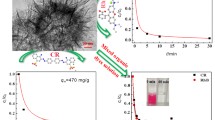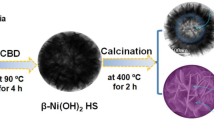Abstract
In this manuscript, a facile strategy was proposed to synthesize hollow spherical polyaniline by using the functionalized polystyrene sphere as the template, the resulting hollow spherical polyanilines were primarily uniform and few of them were stuck together. The obtained polyaniline was semicrystalline emeraldine with the SBET of 14.1 m2 g−1 and an average diameter of 300 nm as well as a shell thickness of 100 nm. This strategy probably provided a potential way to synthesis of the hollow spherical polyaniline. Furthermore, the synthesized hollow spherical polyaniline displayed high adsorption capacity of CR (46.91 mg g−1) and RhB (61.75 mg g−1). These values were higher than many other polyaniline-based adsorbents. The results suggested that the fabricated hollow spherical polyaniline had potential to be employed as adsorbent for CR and RhB removal.








Similar content being viewed by others
References
Zhang L, Wan M (2003) Self-assembly of polyaniline-from nanotubes to hollow microspheres. Adv Funct Mater 13:815–820. https://doi.org/10.1002/adfm.200304458
Liu T, Zhang L, Cheng B, You W, Yu J (2018) Fabrication of a hierarchical NiO/C hollow sphere composite and its enhanced supercapacitor performance. ChemComm 54:3731–3734. https://doi.org/10.1039/C8CC00991K
Wu H, Wang Q, Fei G, Xu S, Guo X, De L (2018) Preparation of hollow polyaniline micro/nanospheres and their removal capacity of Cr(VI) from wastewater. Nanoscale Res Lett 13:1–9. https://doi.org/10.1186/s11671-018-2815-8
Wu K, Zhou L, Jia C, Sun L, Yan C (2017) Pt-embedded-CeO2 hollow spheres for enhancing CO oxidation performance. Mater Chem Front 1:1754–1763. https://doi.org/10.1039/C7QM00244K
Zhu C, Wang H, Guan C (2020) Recent progress on hollow array architectures and their applications in electrochemical energy storage. Nanoscale Horiz 5:1188–1199. https://doi.org/10.1039/D0NH00332H
Wang Q, Zhang Y, Xiao J, Jiang H, Li X, Meng C (2019) A novel ordered hollow spherical nickel silicate-nickel hydroxide composite with two types of morphologies for enhanced electrochemical storage performance. Mater Chem Front 3:2090–2101. https://doi.org/10.1039/C9QM00392D
Shao T, You H, Zhai Z, Liu T, Li M, Zhang L (2017) Hollow spherical LaNiO3 supercapacitor electrode synthesized by a facile template-free method. Mater Lett 201:122–124. https://doi.org/10.1016/j.matlet.2017.04.143
Maity J, Bhattacharjee G, Satpati B, Sardar D, Ghosalya M, Bala T (2019) Dexterous route for synthesis of hollow spherical ZnO and ZnO-Ag nanocomposite with superior photocatalytic ability. ChemistrySelect 4:5518–5526. https://doi.org/10.1002/slct.201900760
Liu X, Wu J, Zhang S, Ding C, Sheng G, Alsaedi A, Hayat T, Li J, Song Y (2019) Amidoxime-functionalized hollow carbon spheres for efficient removal of uranium from wastewater. ACS Sustain Chem Eng 7:10800–10807. https://doi.org/10.1021/acssuschemeng.9b01616
Meng Q, Cai K, Chen Y, Chen L (2017) Research progress on conducting polymer based supercapacitor electrode materials. Nano Energy 36:268–285. https://doi.org/10.1016/j.nanoen.2017.04.040
Wang F, Zhang Y, Fang Q, Li Z, Lai Y, Yang H (2021) Prepared PANI@nano hollow carbon sphere adsorbents with lappaceum shell like structure for high efficiency removal of hexavalent chromium. Chemosphere 263:128109. https://doi.org/10.1016/j.chemosphere.2020.128109
Kumar A, Kumar V, Awasthi K (2018) Polyaniline-carbon nanotube composites: preparation methods, properties, and applications. Polym Plast Technol Eng 57:70–97. https://doi.org/10.1080/03602559.2017.1300817
Chung H, Won J, Zelenay P (2013) Active and stable carbon nanotube/nanoparticle composite electrocatalyst for oxygen reduction. Nat Commun 4:1–5. https://doi.org/10.1038/ncomms2944
Gao Z, Yang W, Wang J, Wang B, Li Z, Liu Q, Zhang M, Liu L (2013) A new partially reduced graphene oxide nanosheet/polyaniline nanowafer hybrid as supercapacitor electrode material. Sustain Energy Fuels 27:568–575. https://doi.org/10.1021/ef301795g
Flouda P, Quinn A, Patel A, Loufakis D, Lagoudas D, Lutkenhaus L (2020) Branched aramid nanofiber-polyaniline electrodes for structural energy storage. Nanoscale 12:16840–16850. https://doi.org/10.1039/D0NR04573J
Liu L, Wang Y, Meng Q, Cao B (2017) A novel hierarchical graphene/polyaniline hollow microsphere as electrode material for supercapacitor applications. J Mater Sci 52:7969–7983. https://doi.org/10.1007/s10853-017-1000-2
Dutta S, Manna K, Srivastava S, Gupta A, Yadav M (2020) Hollow polyaniline microsphere/Fe3O4 nanocomposite as an effective adsorbent for removal of arsenic from water. Sci Rep 10:1–14. https://doi.org/10.1038/s41598-020-61763-z
Tohidi T, Tohidi S, Mohammad-Rezaei R (2020) Fabrication of flexible polyaniline@ZnO hollow sphere hybrid films for high-performance NH3 sensors. J Mater Sci Mater Electron 31:19119–19129. https://doi.org/10.1007/s10854-020-04448-7
Toumi I, Djelad H, Chouli F, Benyoucef A (2022) Synthesis of PANI@ZnO hybrid material and evaluations in adsorption of congo red and methylene blue dyes: structural characterization and adsorption performance. J Inorg Organomet Polym Mater 32:112–121. https://doi.org/10.1007/s10904-021-02084-0
Bekhoukh A, Moulefera I, Zeggai F, Benyoucef A, Bachari K (2021) Anionic methyl orange removal from aqueous solutions by activated carbon reinforced conducting polyaniline as adsorbent: synthesis, characterization, adsorption behavior, regeneration and kinetics study. J Polym Environ 30:886–895. https://doi.org/10.1007/s10924-021-02248-6
Zhang Y, Fang F, Chen Y, Li M, Li L, Li W, Zhang J (2021) Hollow mesoporous polyaniline nanoparticles with high drug payload and robust photothermal capability for cancer combination therapy. Chin J Chem Eng 38:221–228. https://doi.org/10.1016/j.cjche.2021.03.011
Zhu W, Chen Z, Pan Y, Dai R, Wu Y, Zhuang Z, Wang D, Peng Q, Chen C, Li Y (2019) Functionalization of hollow nanomaterials for catalytic applications: nanoreactor construction. Adv Mater 31:1800426. https://doi.org/10.1002/adma.201800426
Yang W, Gao Z, Song N, Zhang Y, Yang Y, Wang J (2014) Synthesis of hollow polyaniline nano-capsules and their supercapacitor application. J Power Sour 272:915–921. https://doi.org/10.1016/j.jpowsour.2014.09.013
Li Z, Hu J, Li Y, Zheng F, Liu J (2018) Self-healing active anticorrosion coatings with polyaniline/cerium nitrate hollow microspheres. Surf Coat Technol 341:64–70. https://doi.org/10.1016/j.surfcoat.2017.11.054
He L, Cui B, Liu J, Song Y, Wang M, Peng D, Zhang Z (2018) Novel electrochemical biosensor based on core-shell nanostructured composite of hollow carbon spheres and polyaniline for sensitively detecting malathion. Sens Actuators B Chem 258:813–821. https://doi.org/10.1016/j.snb.2017.11.161
Xie Y, Kocaefe D, Chen C, Kocaefe Y (2016) Review of research on template methods in preparation of nanomaterials. J Nanomater 2016:1–10. https://doi.org/10.1155/2016/2302595
Chang N, Tang H, Bai L, Zhang Y, Zeng G (2018) Optimized rapid thermal processing for the template removal of SAPO-34 zeolite membranes. J Membr Sci 552:13–21. https://doi.org/10.1016/j.memsci.2018.01.066
Lee D, Jung J, Jung M, Lee S (2015) Hierarchical porous carbon fibers prepared using a SiO2 template for high-performance EDLCs. Chem Eng J 263:62–70. https://doi.org/10.1016/j.cej.2014.10.070
Chen Z, Cui Z, Niu F, Jiang L, Song W (2010) Pd nanoparticles in silica hollow spheres with mesoporous walls: a nanoreactor with extremely high activity. ChemComm 46:6524–6526. https://doi.org/10.1039/C0CC01786H
Liao G, Gong Y, Yi C, Xu Z (2017) Soluble, antibaterial, and anticorrosion studies of sulfonated polystyrene/polyaniline/silver nanocomposites prepared with the sulfonated polystyrene template. Chin J Chem 35:1157–1164. https://doi.org/10.1002/cjoc.201600816
Cho S, Heo G, Khan S, Huang J, Hunstad D, Elsabahy M, Wooley K (2018) A vinyl ether-functional polycarbonate as a template for multiple postpolymerization modifications. Macromolecules 51:3233–3242. https://doi.org/10.1021/acs.macromol.8b00047
Liu R, Yang Z, Chen S, Yao J, Mu Q, Peng D, Zhao H (2019) Synthesis and facile functionalization of siloxane based hyper-cross-linked porous polymers and their applications in water treatment. Eur Polym J 119:94–101. https://doi.org/10.1021/acsami.9b07874
Huang K, Wan M, Long Y, Chen Z, Wei Y (2005) Multi-functional polypyrrole nanofibers via a functional dopant-introduced process. Synth Met 155:495–500. https://doi.org/10.1016/j.synthmet.2005.06.013
Stejskal J, Kratochvil P, Radhakrishnan N (1993) Polyaniline dispersions 2 UV-Vis absorption spectra. Synth Met 61:225–231. https://doi.org/10.1016/0379-6779(93)91266-5
Fan W, Zhang C, Tjiu WW et al (2013) Graphene-wrapped polyaniline hollow spheres as novel hybrid electrode materials for supercapacitor applications. ACS Appl Mater Inter 5(8):3382–3391. https://doi.org/10.1021/am4003827
Yang C, Li H, Xiong D et al (2009) Hollow polyaniline/Fe3O4 microsphere composites: preparation, characterization, and applications in microwave absorption. React Funct Polym 69(2):137–144. https://doi.org/10.1016/j.reactfunctpolym.2008.12.008
Moharram MA, Allam MA (2007) Study of the interaction of poly (acrylic acid) and poly (acrylic acid-poly acrylamide) complex with bone powders and hydroxyapatite by using TGA and DSC. J Appl Polym Sci 105(6):3220–3227. https://doi.org/10.1002/app.26267
Patra B, Majhi D (2015) Removal of anionic dyes from water by potash alum doped polyaniline: investigation of kinetics and thermodynamic parameters of adsorption. J Phys Chem B 119:8154–8164. https://doi.org/10.1021/acs.jpcb.5b00535
Xu B, Wang X, Huang Y, Liu J, Wang D, Feng S, Huang X, Wang H (2020) Electrospinning preparation of PAN/TiO2/PANI hybrid fiber membrane with highly selective adsorption and photocatalytic regeneration properties. Chem Eng J 399:125749. https://doi.org/10.1016/j.cej.2020.125749
Zhang Y, Han H, Wang X, Zhang M, Chen Y, Zhai C, Song H, Deng J, Sun J, Zhang C (2021) Utilization of NaP zeolite synthesized with different silicon species and NaAlO2 from coal fly ash for the adsorption of rhodamine B. J Hazard Mater 415:125627. https://doi.org/10.1016/j.jhazmat.2021.125627
Zhang Z, Li Y, Du Q, Li Q (2018) Adsorption of congo red from aqueous solutions by porous soybean curd xerogels. Pol J Chem Technol 20:95–102. https://doi.org/10.2478/pjct-2018-0044
Mahanta D, Madras G, Radhakrishnan S, Patil S (2008) Adsorption of sulfonated dyes by polyaniline emeraldine salt and its kinetics. J Phys Chem B 112:10153–10157. https://doi.org/10.1021/jp803903x
Acknowledgements
The work was supported by Shandong Provincial Natural Science Foundation (ZR2017LEM013, ZR2021QE140), Shandong Provincial Key R&D Program (Grant No. 2019GGX102066), the National Natural Science Foundation of China (31901589, 52103114), Colleges and Universities Twenty Foundational Projects of Jinan City (2021GXRC068) and the Program for Scientific Research Innovation Team in Colleges and Universities of Jinan (No. 2018GXRC006) for financial support.
Author information
Authors and Affiliations
Corresponding authors
Ethics declarations
Conflict of interest
The authors declare that there is no conflict to declare.
Additional information
Publisher's Note
Springer Nature remains neutral with regard to jurisdictional claims in published maps and institutional affiliations.
Rights and permissions
About this article
Cite this article
Wu, Y., Chang, H., Peng, J. et al. A facile strategy to fabricate hollow spherical polyaniline and its application to dyes removal. Polym. Bull. 80, 3675–3688 (2023). https://doi.org/10.1007/s00289-022-04231-0
Received:
Revised:
Accepted:
Published:
Issue Date:
DOI: https://doi.org/10.1007/s00289-022-04231-0




